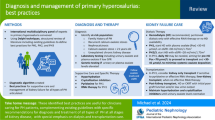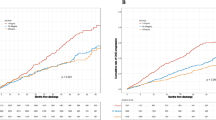Abstract
Plasma concentration of asymmetric dimethylarginine (ADMA), an endogenous inhibitor of nitric oxide (NO) synthesis from l-arginine and a cardiovascular risk factor, was found to be elevated in plasma of homocysteinemic adults. Enhanced cardiovascular risk due to homocystinuria and impaired renal function has been found in patients with phenylketonuria (PKU) on protein-restricted diet. However, it is still unknown whether ADMA synthesis is also elevated in children with homocystinuria due to cystathionine beta-synthase deficiency (classical homocystinuria), and whether ADMA may play a role in phenylketonuria in childhood. In the present study, we investigated the status of the l-arginine/NO pathway in six young patients with homocystinuria, in 52 young phenylketonuria patients on natural protein-restricted diet, and in age- and gender-matched healthy children serving as controls. ADMA in plasma and urine was determined by GC–MS/MS. The NO metabolites nitrate and nitrite in plasma and urine, and urinary dimethylamine (DMA), the dimethylarginine dimethylaminohydrolase (DDAH) metabolite of ADMA, were measured by GC–MS. Unlike urine ADMA excretion, plasma ADMA concentration in patients with homocystinuria was significantly higher than in controls (660 ± 158 vs. 475 ± 77 nM, P = 0.035). DMA excretion rate was considerably higher in children with homocystinuria as compared to controls (62.2 ± 24.5 vs. 6.5 ± 2.9 μmol/mmol creatinine, P = 0.068), indicating enhanced DDAH activity in this disease. In contrast and unexpectedly, phenylketonuria patients had significantly lower ADMA plasma concentrations compared to controls (512 ± 136 vs. 585 ± 125 nM, P = 0.009). Phenylketonuria patients and controls had similar l-arginine/ADMA molar ratios in plasma. Urinary nitrite excretion was significantly higher in phenylketonuria as compared to healthy controls (1.7 ± 1.7 vs. 0.7 ± 1.2 μmol/mmol creatinine, P = 0.003). Our study shows that the l-arginine/NO pathway is differently altered in children with phenylketonuria and homocystinuria. Analogous to hyperhomocysteinemic adults, elevated ADMA plasma concentrations could be a cardiovascular risk factor in children with homocystinuria. In phenylketonuria, the l-arginine/NO pathway seems not be altered. Delineation of the role of ADMA in childhood phenylketonuria and homocystinuria demands further investigation.



Similar content being viewed by others
References
Achan V, Broadhead M, Malaki M, Whitley G, Leiper J, MacAlister R, Vallance P (2003) Asymmetric dimethylarginine causes hypertension and cardiac dysfunction in humans and is actively metabolized by dimethylarginine dimethylaminohydrolase. Arterioscler Thromb Vasc Biol 23:1455–1459
Austin RC, Lentz SR, Werstuck GH (2004) Role of hyperhomocystinuria in endothelial dysfunction and atherothrombotic disease. Cell Death Differ 11:56–64
Böger RH, Zoccali C (2003) ADMA: a novel risk factor that explains excess cardiovascular event rate in patients with end-stage renal disease. Atheroscler Suppl 4:23–28
Böger RH, Bode-Böger SM, Thiele W, Junker W, Alexander K, Frölich JC (1997) Biochemical evidence for impaired nitric oxide synthesis in patients with peripheral arterial occlusive disease. Circulation 95:2068–2074
Cines DB, Pollak ES, Buck CA, Loscalzo J, Zimmerman GA, McEver RP, Pober JS, Wick TM, Konkle BA, Schwarzt BS, Barnathan ES, McCrae KR, Hug BA, Schmidt AM, Stern DM (1998) Endothelial cells in physiology and in the pathophysiology of vascular disorders. Blood 91:3527–3561
Cooke JP, Dzau VJ (1997) Nitric oxide synthase: role in the genesis of vascular disease. Annu Rev Med 48:489–509
Dayal S, Lentz SR (2005) ADMA and hyperhomocystinuria. Vasc Med 10(Suppl 1):27–33
Dayal S, Rodionov RN, Arning E, Bottiglieri T, Kimoto M, Murry DJ, Cooke JP, Faraci FM, Lentz SR (2008) Tissue-specific downregulation of dimethylarginine dimethylaminohydrolase in hyperhomocystinuria. Am J Physiol Heart Circ Physiol 295:H816–H825
Hennermann JB, Roloff S, Gellermann J, Vollmer I, Mönch E (2005) Renal function in adolescent and adult patients with phenylketonuria. J Inherit Metab Dis 28(Supp 1):18
Kielstein JT, Tsikas D, Fliser D (2006) Effects of asymmetric dimethylarginine (ADMA) infusion in humans. Eur J Clin Pharmacol 62:39–44
Kielstein A, Tsikas D, Galloway GP, Mendelson JE (2007) Asymmetric dimethylarginine (ADMA): A modulator of nociception in opiate tolerance and addiction? Nitric Oxide 17:55–59
Korandji C, Zeller M, Guilland JC, Vergely C, Sicard P, Duvillard L, Gambert P, Moreau D, Cottin Y, Rochette L (2007) Asymmetric dimethylarginine (ADMA) and hyperhomocystinuria in patients with acute myocardial infarction. Clin Biochem 60:66–72
Lücke T, Tsikas D, Kanzelmeyer N, Vaske B, Das AM (2006) Elevated plasma concentrations of the endogenous nitric oxide synthase inhibitor asymmetric dimethylarginine (ADMA) in citrullinemia. Metabolism 55:1599–1603
Lücke T, Kanzelmeyer N, Kemper MJ, Tsikas D, Das AM (2007) Developmental changes in the l-arginine/nitric oxide pathway from infancy to adulthood: plasma asymmetric dimethylarginine levels decrease with age. Clin Chem Lab Med 45:1525–1530
Lücke T, Kanzelmeyer N, Chobanyan K, Tsikas D, Franke D, Kemper MJ, Ehrich JH, Das A (2008) Elevated asymmetric dimethylarginine (ADMA) and inverse correlation between circulating ADMA and glomerular filtration rate in children with sporadic focal segmental glomerulosclerosis (FSGS). Nephrol Dial Transpl 23:734–740
Mansoor MA, Kristensen O, Hervig T, Stakkestad JA, Berge T, Drablos PA, Rolfsen S, Wentzel-Larsen T (2005) Relationship between serum folate and plasma nitrate concentrations: possible clinical implications. Clin Chem 51:1266–1268
Moens AL, Kass DA (2006) Tetrahydrobiopterin and cardiovascular disease. Arterioscler Thromb Vasc Biol 26:2439–2444
Mudd SH, Skovby F, Levy HL, Pettigrew KD, Wilcken B, Pyeritz RE, Andria G, Boers GHJ, Bromberg IL, Cerone R, Fowler B, Gröbe H, Schmidt H, Schweitzer L (1985) The natural history of homocystinuria due to cystathionine beta-synthase deficiency. Am J Hum Genet 37:1–31
Ozkor MA, Quyyumi AA (2008) Tetrahydrobiopterin. Curr Hypertens Rep 10:58–64
Pham VV, Stichtenoth DO, Tsikas D (2009) Nitrite correlates with 3-nitrotyrosine but not with the F2-isoprostane 15(S)-8-iso-PGF2α in urine of rheumatic patients. Nitric Oxide 21:210–215
Schmidt TS, Alp NJ (2007) Mechanisms for the role of tetrahydrobiopterin in endothelial function and vascular disease. Clin Sci 113:47–63
Schroecksnadel K, Weiss G, Stanger O, Teerlink T, Fuchs D (2007) Increased asymmetric dimethylarginine concentrations in stimulated peripheral blood mononuclear cells. Scand J Immunol 65:525–529
Schulpis KH, Karikas GA, Papakonstantinou E (2002) Homocysteine and other vascular risk factors in patients with phenylketonuria on a diet. Acta Paediatr 91:905–909
Sitta A, Barschak AG, Deon M, Terroso T, Pires R, Giugliani R, Dutra-Filho CS, Wajner M, Vargas CR (2006) Investigation of oxidative stress parameters in treated phenylketonuric patients. Metab Brain Dis 21:287–296
Spoelstra-de Man AM, Teerlink T, Brouwer CB, Rauwerda JA, Stehouwer CD, Smuöders YM (2006) No effect of B vitamins an ADMA levels in patients at increased cardiovascular risk. Clin Endocrinol 65:495–501
Tsikas D (2000) Simultaneous derivatization and quantification of the nitric oxide metabolites nitrite and nitrate in biological fluids by gas chromatography–mass spectrometry. Anal Chem 72:4064–4072
Tsikas D (2003) Incorrect and inconsistent use of homocysteine’s nomenclature: a potential source of misunderstandings. Eur J Clin Invest 33:1095–1096
Tsikas D (2008) A critical review and discussion of analytical methods in the l-arginine/nitric oxide area of basic and clinical research. Anal Biochem 379:139–163
Tsikas D, Böger RH, Sandmann J, Bode-Böger SM, Frölich JC (2000) Endogenous nitric oxide synthase inhibitors are responsible for the l-arginine paradox. FEBS Lett 478:1–3
Tsikas D, Schubert B, Gutzki FM, Sandmann J, Frölich JC (2003) Quantitative determination of circulating and urinary asymmetric dimethylarginine (ADMA) in humans by gas chromatography–tandem mass spectrometry as methyl ester tri(N-pentafluoropropionyl) derivative. J Chromatogr B 798:87–99
Tsikas D, Wolf A, Frölich JC (2004) Simplified HPLC method for urinary and circulating creatinine. Clin Chem 50:201–203
Tsikas D, Gutzki FM, Stichtenoth DO (2006) Circulating and excretory nitrite and nitrate as indicators of nitric oxide synthesis in humans: methods of analysis. Eur J Clin Pharmacol 62:51–59
Tsikas D, Thum T, Becker T, Pham VV, Chobanyan K, Mitschke A, Beckmann B, Gutzki FM, Bauersachs J, Stichtenoth DO (2007) Accurate quantification of dimethylamine (DMA) in human urine by gas chromatography–mass spectrometry as pentafluorobenzamide derivative: evaluation of the relationship between DMA and its precursor asymmetric dimethylarginine. J Chromatogr B 851:229–239
Tsikas D, Schwarz A, Stichtenoth DO (2010) Simultaneous measurement of [15N]nitrate and [15N]nitrite enrichment and concentration in urine by gas chromatography mass spectrometry as pentafluorobenzyl derivatives. Anal Chem 82:2585–2587
Verduyn I, Bosdet T, Selvage C, Sirrs S, O’Riley M (2005) Reduced HDL levels in adult patients with phenylketonuria (PKU). J Inherit Metab Dis 28(Suppl 1):56–64
Welch GN, Loscalzo J (1998) Homocysteine and atherothrombosis. N Engl J Med 338:1042–1050
Williams RA, Mamotte CDS, Burnett JR (2008) Phenylketonuria: an inborn error of phenylalanine metabolism. Clin Biochem Rev 29:31–41
Wolf C, Lorenzen JM, Stein S, Tsikas D, Störk S, Weidemann F, Ertl G, Anker SD, Bauersachs J, Thum T (2010) Urinary asymmetric dimethylarginine (ADMA) is a predictor of mortality risk in patients with coronary artery disease. Intern J Cardiol. doi:10.1016/j.ijcard.2010.11.003
Wu G (2009) Amino acids: metabolism, functions, and nutrition. Amino Acids 37:1–17
Wu G, Bazer FW, Davis TA, Kim SW, Li P, Rhoads JM, Satterfield MC, Smith SB, Spencer TE, Yin Y (2009) Arginine metabolism and nutrition in growth, health and disease. Amino Acids 37:153–168
Acknowledgments
The authors would like to thank A. Mitschke for the excellent laboratory assistance and F.-M. Gutzki for performing GC–MS and GC–MS/MS analyses.
Conflict of interest
The authors declare that they have no conflict of interest.
Author information
Authors and Affiliations
Corresponding authors
Additional information
N. Kanzelmeyer and D. Tsikas contributed equally to this work and are both corresponding authors.
Rights and permissions
About this article
Cite this article
Kanzelmeyer, N., Tsikas, D., Chobanyan-Jürgens, K. et al. Asymmetric dimethylarginine in children with homocystinuria or phenylketonuria. Amino Acids 42, 1765–1772 (2012). https://doi.org/10.1007/s00726-011-0892-4
Received:
Accepted:
Published:
Issue Date:
DOI: https://doi.org/10.1007/s00726-011-0892-4




